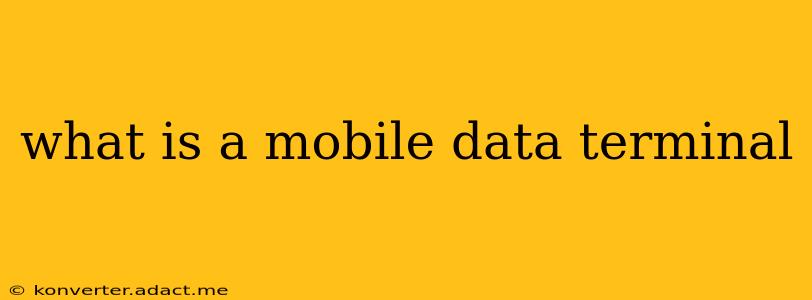A Mobile Data Terminal (MDT) is a versatile device that allows for the transmission and reception of data while in motion. Unlike a simple mobile phone, its primary function is to facilitate data communication, often integrating various technologies and functionalities to achieve this goal. Think of it as a ruggedized, specialized computer designed for use in vehicles or other mobile environments where reliable data connectivity is crucial. They are found in a variety of industries and applications, each demanding specific features and capabilities.
What are the different types of Mobile Data Terminals?
MDTs come in various forms, each tailored to specific needs and environments. The core functionality remains consistent—data transmission and reception—but the implementation can differ significantly.
-
Vehicle-mounted MDTs: These are the most common type, typically integrated into vehicles like trucks, emergency response vehicles, or delivery vans. They often incorporate features like GPS tracking, dispatch communication, and onboard diagnostics.
-
Handheld MDTs: These portable devices offer flexibility and mobility, ideal for applications where workers need to move around freely while maintaining data access. They often utilize ruggedized designs to withstand harsh conditions.
-
Specialized MDTs: Industries like transportation, logistics, and public safety may require specialized MDTs with features unique to their operations. For example, an MDT used by a utility company may integrate specific software for managing power grids, while a law enforcement MDT might focus on real-time crime information access.
What are the key features of a Mobile Data Terminal?
Several key features are common among most MDTs, contributing to their overall functionality and efficiency:
-
Connectivity: MDTs rely on various connectivity options, such as cellular (4G LTE, 5G), satellite, and Wi-Fi, to ensure consistent data transmission even in remote areas.
-
GPS Navigation: Real-time location tracking is a vital component for many MDT applications. This enables efficient routing, fleet management, and asset tracking.
-
Data Acquisition and Processing: MDTs collect data from various sources, such as sensors, onboard diagnostics, and user input. They then process this information and present it in a user-friendly format.
-
Software Applications: The specific software applications running on the MDT define its functionality. These apps can include dispatch systems, navigation software, work order management tools, and more.
-
Ruggedized Design: Many MDTs are designed to withstand harsh environmental conditions, including extreme temperatures, vibration, and dust, ensuring reliable operation in challenging situations.
What are the benefits of using a Mobile Data Terminal?
The advantages of employing MDTs are numerous, boosting operational efficiency and enhancing decision-making across diverse sectors:
-
Improved Communication: Real-time communication between mobile workers and dispatch centers improves response times and coordination.
-
Enhanced Efficiency: Optimized routing and task management through MDTs reduce travel time and increase productivity.
-
Increased Safety: Real-time location tracking and emergency communication capabilities enhance safety for mobile workers.
-
Better Data Management: Centralized data collection and analysis offer valuable insights into operations, enabling better strategic decision-making.
-
Reduced Operational Costs: Optimized routing, reduced idle time, and improved efficiency translate into significant cost savings.
How is a Mobile Data Terminal different from a Tablet or Smartphone?
While tablets and smartphones can perform some of the same functions as an MDT, several key distinctions exist:
-
Ruggedness: MDTs are typically built to withstand harsher conditions than consumer-grade tablets or smartphones. They are often designed to resist shocks, vibrations, and extreme temperatures.
-
Connectivity Options: MDTs often offer a broader range of connectivity options, including satellite communication, which may be unavailable on typical consumer devices.
-
Specialized Software: MDTs are frequently equipped with purpose-built software applications tailored to the specific industry and operational needs, unlike the general-purpose apps on consumer devices.
-
Power Management: MDTs often have extended battery life and more robust power management systems to sustain continuous operation.
What industries use Mobile Data Terminals?
Mobile Data Terminals find applications across a broad spectrum of industries. Here are just a few examples:
- Transportation and Logistics: Fleet management, delivery tracking, and driver communication.
- Public Safety: Police, fire, and emergency medical services dispatch and communication.
- Utilities: Field service management for electricity, gas, and water companies.
- Construction: Equipment tracking, worker safety monitoring, and project management.
- Field Service: Technician dispatch, work order management, and client communication.
In conclusion, a Mobile Data Terminal is much more than a simple device; it is a critical component in many industries, enabling efficient communication, data management, and operational optimization in dynamic mobile environments. The specific features and capabilities of an MDT vary depending on its intended application, but the core functionality of reliable data transmission while in motion remains constant.
